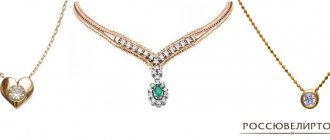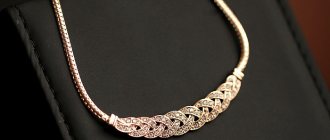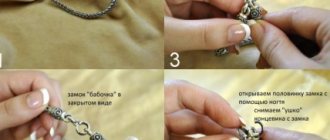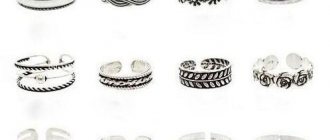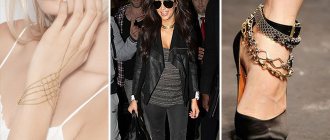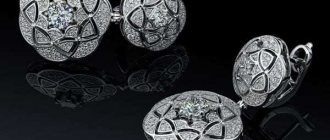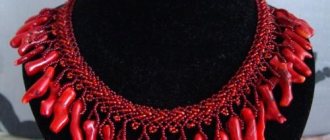These two names for neck jewelry - choker and necklace - are often confused. So first, let's understand the terms. If we turn to the origin of these words, we will find the reason for the confusion in the names. The fact is that the word “necklace” basically means the same thing as the word “necklace”. Word "necklace" comes from the Old Slavic “gerlo”, which meant the front of the neck - “throat”. That is, in the literal sense, the “necklace” is what is around the throat. In Ancient Rus', a necklace was a collar and collar of chain mail, as well as the neck of a cow or bull. And later this word began to be used to describe various jewelry that was worn around the neck. The word is "necklace" – (English collier), came to us from France and translated means “collar” or “worn around the neck.” Today the word "necklace" in Russian is used to name a certain type of neck decoration.
What is the difference between a necklace and a necklace?
A necklace is a neck decoration that is made in the form of a hoop or chain with inserts made of precious stones or beads in a frame. Decorative fittings and castes made of precious or base metals are used as frames. There are different types of necklaces : with a flexible or rigid hoop, there are solid ones and there are links. The necklaces have a variety of inserts - diamond, pearl, precious or semi-precious stones. But the main difference between a necklace and a choker is that the inserts in this decoration are either the same or close in size.
Necklace examples:
Unlike a necklace, a choker is an ornament of a more complex design. It has a pronounced central part. It is larger in size than the other parts of the necklace, and is made in the form of one or more decorative elements. A necklace is often a very expensive, highly artistic piece of jewelry, made of precious metals and decorated with precious stones.
Necklace examples:
The central element of the necklace can be made of beads or stones, or it can be all kinds of pendants - pendants, medallions, amulets, tassels and the like. The clasp is also an essential element of the necklace; it allows you to adjust the tightness of the decoration to the neck.
Examples of central necklace decorative elements:
Summarize. The difference between a necklace and a necklace is that a necklace has a clearly defined central part, while in a necklace all elements are distributed relatively evenly along the entire length of the jewelry.
Gallery[edit]
- Tiffany Opal necklace
- Minoan gold necklace (Arkhm Heraklion)
- Napoleonic era diamond necklace
- Emerald Necklace
- Egyptian necklace made of carnelian, limestone and quartz
- Gold ancient Byzantine pendant necklace
- Vandal necklace in gold and glass, ca. 300 AD
- Necklace with relief pendant
- Silver necklace, c. 600-650 Ad
- Frankish glass bead necklace
- Byzantine Christian cross necklace
- Byzantine Christian cross necklace
- Gold and platinum necklace
- German metal necklace
- Crochet lace, pearl and sterling silver necklace.
- Gold and platinum French necklace
- Glass Necklace
- Rosaline Pearl Necklace
- Dirce Repossi necklace in white gold and diamonds
- Gold Roman Necklace with Coin Charms and Braided Chain - Walters 571600
- Uranium glass necklace, 1940/1950. Uranium glass glows bright green under ultraviolet light.
Types of necklaces by length
Necklaces and necklaces come in the following types: collar (30-35 cm), choker (35-40 cm), princess (42-48 cm) and matinee (50-60 cm) (read more about the types of neck jewelry by length).
Collar and choker types are used to make both necklaces and necklaces. But princess-type necklaces are made very rarely. As for matine, necklaces do not come in this length, but necklaces are sometimes made.
The collar necklace is the shortest piece of jewelry and fits very tightly to the neck. In essence, it is a “collar” that fits tightly around the neck, often in several rows (in translation, collar is a collar).
It should be noted that there is a men's collar necklace , which differs from women's both in its length and purpose. A man's collar indicates status. As a rule, it consists of a chain with massive links and one main pendant, which necessarily has some kind of symbolic image indicating status. It is from here that the symbolic chain decorations that can be seen on city mayors and high-ranking aristocratic persons originated.
Choker necklace – translated from English “choker” means “strangler”, this decoration fits quite tightly around the neck. Chokers are adjustable in girth thanks to various length regulators, and sometimes such jewelry is made according to the customer’s measurements. The choker is a classic necklace that has always been a symbol of elegance and grace - both in chivalrous times and in the Victorian era. Queen Victoria herself adored this jewelry, and the Princess of Wales, thanks to choker necklaces, skillfully hid her scar on her neck. Coco Chanel preferred choker necklaces, placing emphasis on them in her collections.
Braiding beads
The materials required for braiding beads are listed in the table.
| Materials | Quantity |
| Czech beads No. 10 in 2 colors (white and brown) | 1 pack each |
| fishing line | 1 cat. |
| beading needles | 1 pack |
| bead (12 mm) | 1 PC. |
| safety pin | 1 PC. |
Step-by-step braiding of beads:
- You need to put 4 white beads on the fishing line and then close them in a circle.
- Then in row No. 2, between each of the white beads, you need to weave 1 brown bead.
- Next you need to weave row No. 3. To do this, you need to remove the needle from the brown bead and string 2 white beads onto it, passing the fishing line at the end through the brown bead of the previous row.
- Next you need to weave row No. 4. To do this, you need to bring the needle through the white bead of the previous row and place a brown bead on it.
- Next, take a bead that will be braided. Insert a pin into it and secure it with a rubber band.
- Then 2 rows of brown beads are woven through one bead.
- Next, the bead needs to be braided according to the same pattern up to row 14, alternating white and brown beads with each other.
- After this, row No. 15 must be woven according to the pattern: the needle must be brought out through a white bead, then 1 brown bead must be strung on it, and the needle must be brought out by passing it through 2 white beads at once. At the end of the bead will come out a woven square of brown beads.
- In the last row 4 more pieces are added. white beads between the brown beads of the previous row.
- At the end, the thread can be brought out in two ways: either by bringing it out through the braided bead, or by passing the needle through the beads 2-3 rows back.
- The last step is to cut off the remaining thread.
Types of necklaces and necklaces by appearance
Based on their appearance, these decorations are divided into many types. The most common types of necklaces are: riviera, clasp, slavage, plastron.
Riviera collier (necklace) is a type of necklace in which identical or homogeneous stones are connected in such a way that you cannot see the fastening points, which creates the illusion of a flowing river stream. This exceptionally beautiful decoration is appropriate only with an evening outfit.
Clasp (English fermoir, clasp collier, necklace) is a necklace in which the clasp is located in front and is the central part of the decoration. The name comes from the French fermoir - fastener.
Slavage (eng. esclavage collier, necklace). The term comes from the French esclavage - slavery. A slavage necklace consists of chains that form a strip into which inserts of precious stones or beads are attached. A slavage necklace consists of a strip of fabric on which precious stones are attached. The strip with stones clasps the neck quite tightly, and a beautiful pendant falls into the hollow.
Scythe
To make a braid necklace, you just need to put beads on long pieces of fishing line, and then intertwine the resulting threads together.
A necklace made of strands using the braid technique looks very stylish.
What to wear this season?
The favorites of the current season are heavy, massive beads and wide necklaces. They can consist of either metal with inlays and elaborate treasure decorations, or natural large stones of various shapes.
The trend of the year is multi-layered decoration. Multi-row necklaces and choker necklaces will be trendy. With leather inserts made of reptile scales, lace - they do not go out of fashion and look graceful and elegant.
Handmade necklaces in ethnic Victorian style are another major current trend. Huge necklaces and beads with eye-catching beads, knitting elements, and large flowers are relevant at any time. Necklaces in the form of a shirtfront or collar look impressive; they are fully suitable for a strict business style.
Irregular, rough forms of stone that look untreated are considered relevant. The combination of different color combinations in one decoration is relevant.
Weaving a continuous fabric
The materials required for weaving a continuous fabric are presented in the table.
| Materials | Quantity |
| beads of the same size | 1 pack |
| nylon thread | 1 cat. |
Step-by-step creation of weaving using the “solid fabric” technique:
- You need to collect 3 beads on the thread and then distribute them along its center.
- On any side of the thread you need to pick up a connecting bead and thread the second side of the thread into it towards the first and tighten both sides of the thread.
- Then you need to put 1 bead on one side of the thread, and 2 beads on the other side of the thread.
- You need to thread the opposite side of the thread into the top bead and tighten it.
- You should weave in this way until the desired weaving length is obtained.
- Next, the resulting chain must be turned at a right angle, and 2 beads should be placed on the left thread, and 1 bead should be strung on the right thread and both threads should be crossed in it.
- Next you need to weave using the same technique, using the side beads of the previous row.
Mosaic technique
The materials required for the mosaic weaving technique are listed in the table.
| Materials | Quantity |
| Czech beads No. 10 | 1 pack |
| bead thread | 1 cat. |
| bead needle | 1 pack |
Step-by-step weaving using mosaic technique:
- You need to put an even number of beads on the thread (about 20 pieces).
- Next, the empty needle without beads needs to be returned back by threading it through one bead.
- Then for each “lowered” bead you need to place 1 bead one after another.
- Next, you need to turn the needle in the opposite direction and, picking up one bead at a time, pass them through one bead of the weave.
- As a result, you need to make the required number of rows to obtain a fabric of the desired size, made using this weaving technique.
